Filter Relationship Editor
Tier: Launch, Grow, Scale
Offering: Cloud, On-Prem
Note:
Available with the Analytical Engine only.
Dashboard designers can create and manage complex analytical cases independently, without the need to create
custom columns in the model by building relationships between the dashboard filters.
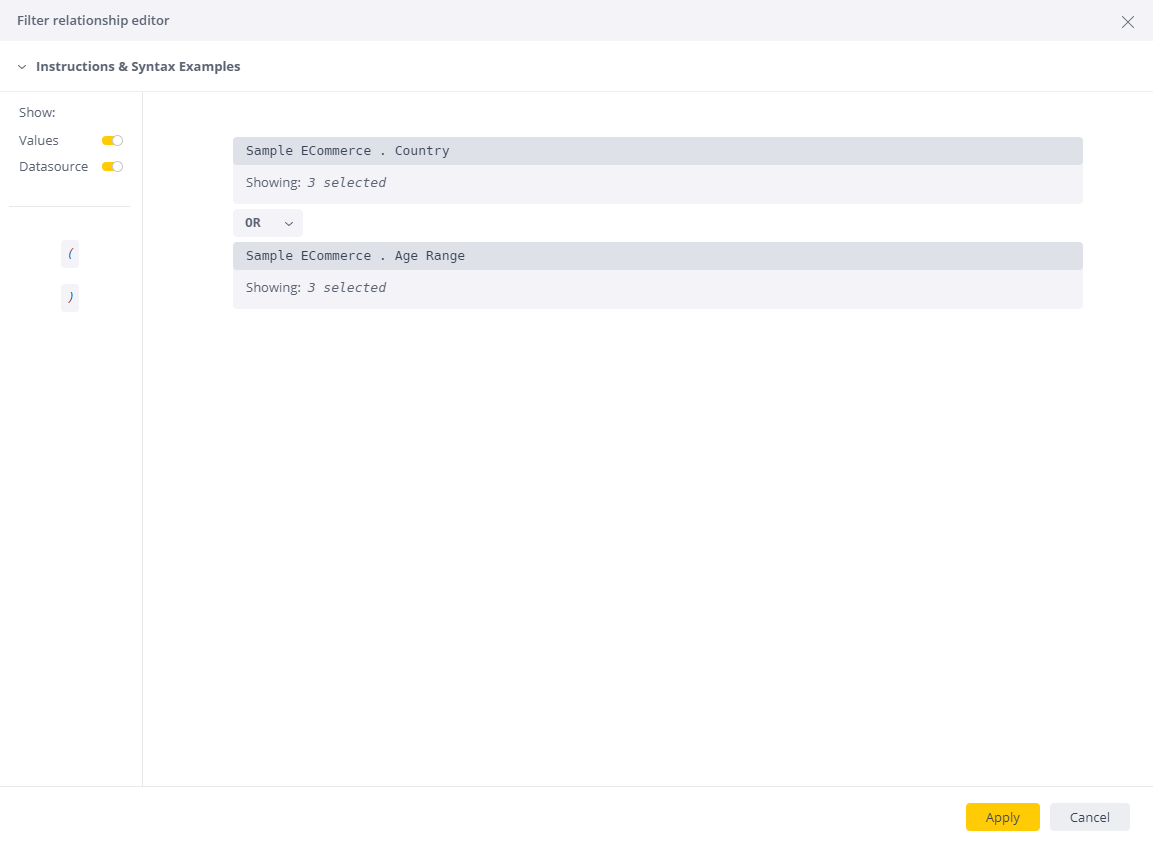
Note:
This is currently for dashboard designers only.
Guidelines
- The filter relationship editor is only used to define the relationships between dashboard filters. (See Creating Dashboard Legacy Filters.)
- Widget filter and dashboard filter interactions:
- If a widget filter is defined for a field for which there is also a dashboard filter, the widget filter settings override the dashboard filter settings.
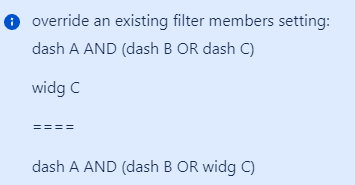
- If a widget filter is defined for a field for which there is no dashboard filter, the relationship between the widget filter and the filter relationship
statement is defined by default as an AND relationship.
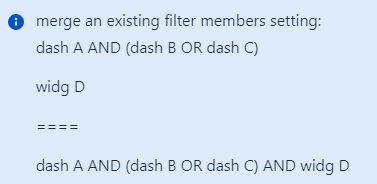
- If a widget filter is defined for a field for which there is also a dashboard filter, the widget filter settings override the dashboard filter settings.
-
The filter relationship statement respects background filters on the dashboard level, so that members/values filtered by a background filter are never presented in the dashboard, including when the filter is part of an 'OR' condition.
The background filters are presented in the filter relationship editor as having the default ‘AND’ relationship with the rest of the filters, which cannot be changed.
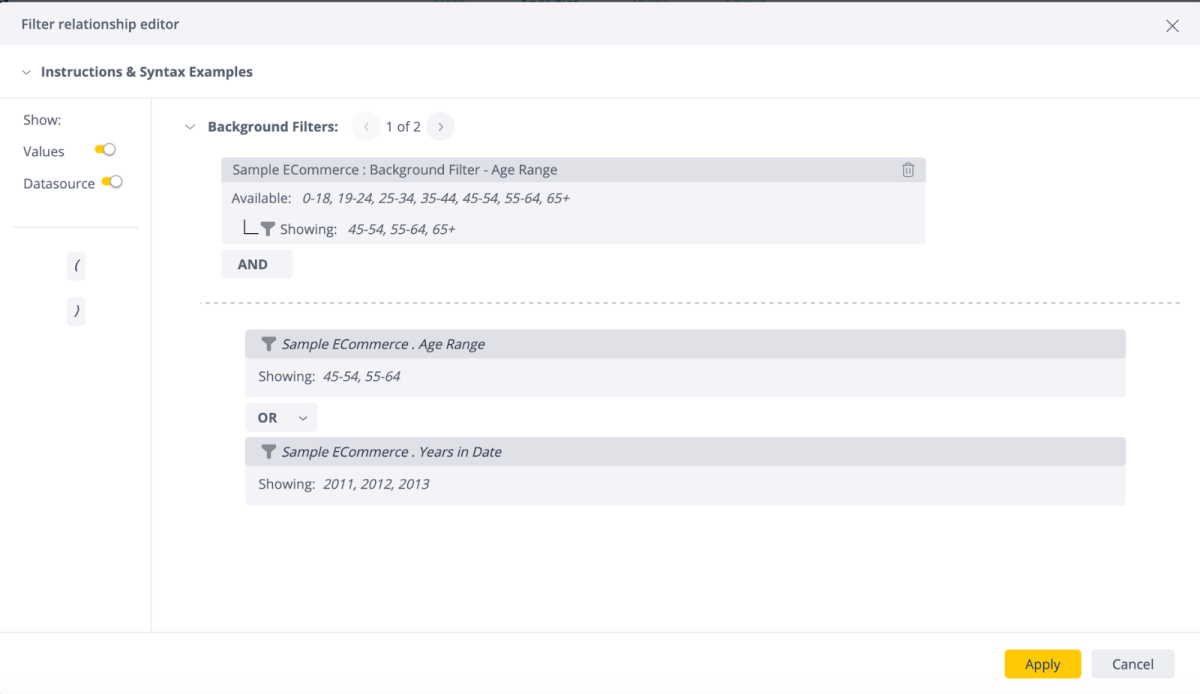
- The maximum number of levels for nested statement blocks using parenthesis is three. This is the default
value. There can be multiple nested blocks within a statement, each reaching the maximum depth of three.
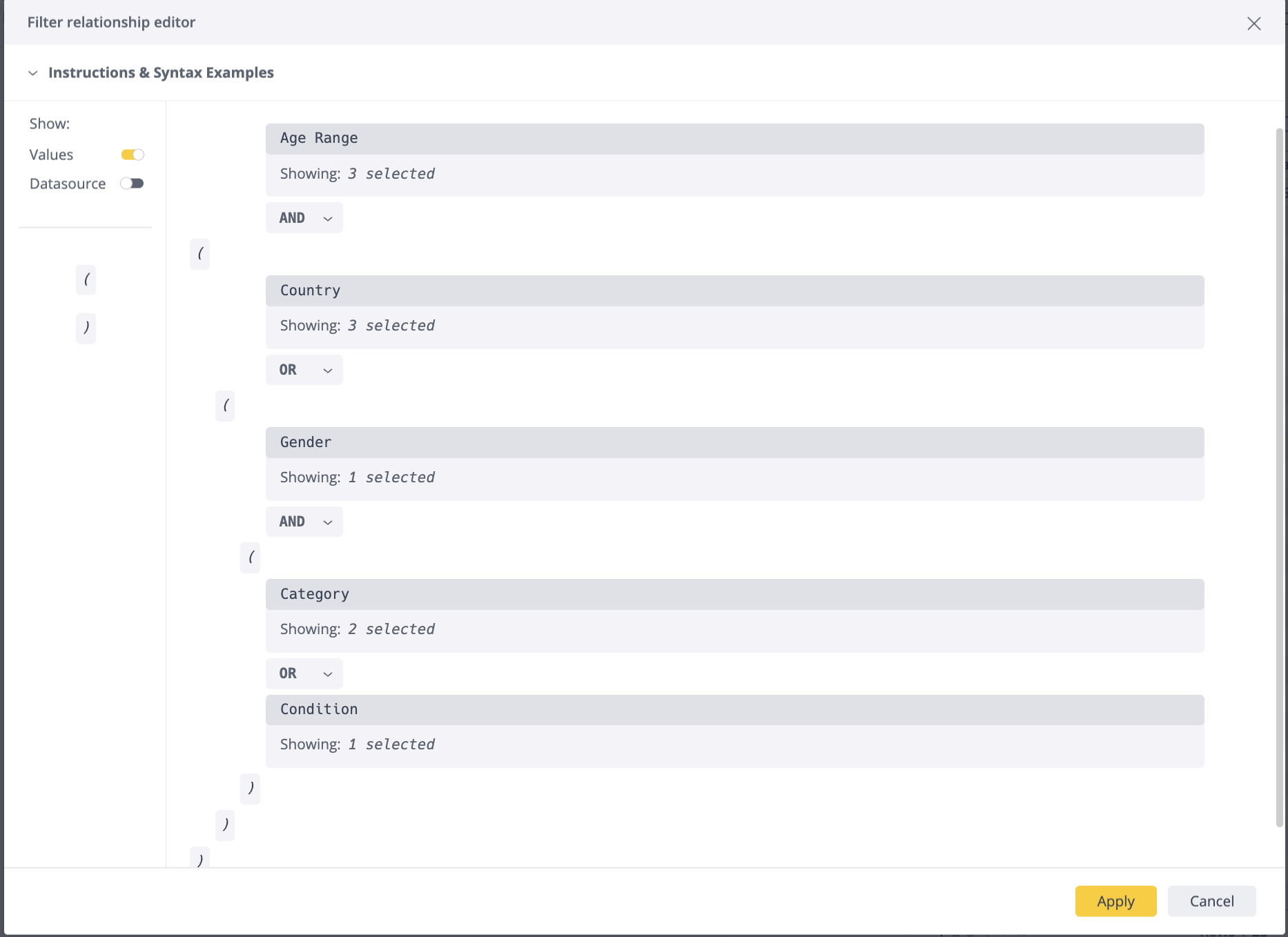
-
The filter relationship statement is part of the assets included in the import/export of the dashboard. You cannot import a dashboard with an incorrect statement.
Filter Blocks in the Filter Relationship Statement
Filter blocks are a textual representation of the dashboard filter in the editor view composed of the currently applied filter relationship statement. The name assigned to the block can include the data source name assigned by the designer when it was first created.
- Use the Datasource toggle in the left pane of the filter relationship editor to show the data source name.
Note:
The filter block behavior detailed in this section is also true for dependent filter blocks.
- Open the Filter Relationship editor from the filter panel to view the statement.

When you first open the statement, the order of the blocks reflects their order in the filter panel. Changing the order of the blocks in the Filter Relationship editor does not affect the order of the filters in the filter panel.
Actions You Can Take from the Filter Relationship Editor
Adding a New Dashboard Filter from the Filter Panel
Editing the Filter Relationship
Removing Dashboard Filters Directly from the Filter Relationship Editor
Viewing the Filter Relationship Statement
Setting and Restoring Default Filters
Adding a New Dashboard Filter from the Filter Panel
When you add a new dashboard filter in the filter panel, it is automatically added to the filter relationship statement with an "and" operator between the new filter and the existing set of filters. This is the default behavior. The filter can be edited later.
Example:
- In your dashboard, in the filter panel, add a filter.
- Click and select Filter Relationship Editor to view the new
filter block in the Filter Relationship Statement.
.png)
Editing the Filter Relationship
Edit the filter relationship at any point, through the filter relationship editor, using intuitive drag an drop and selection boxes. You can edit the relationship between existing dashboard filters to change the query result:
- Change the order of blocks in statement
- Change the operators used between blocks
- Add parenthesis to change the logical order of the statement implementation.
Note: There is a limit of 3 levels of depth per statement blocks hierarchy. There can be multiple hierarchies with depth <=3 per statement. This is unlimited, however performance is expected to be affected by more complex statements.
Example:
- Open the Filter Relationship editor.
- Make changes to the Filter Relationship Statement as follows:
- Change the operators between existing dashboard filters. Available values are: AND, OR
- Add parentheses. There is a limit to the allowed number of statement blocks that are nested using parentheses. See Limitationsfor more information.
- Rearrange filter blocks into different positions with drag and drop. When repositioning a filter block, a new default AND operator is created, and the old redundant operator is removed.
Using Multiple Data Sources
If multiple data sources are used, the filter statement includes all filters from all data sources. The relationships can be defined between the filters within each data source.
See Creating Dashboard Legacy Filters on how to select a data source for the filter.
Example:
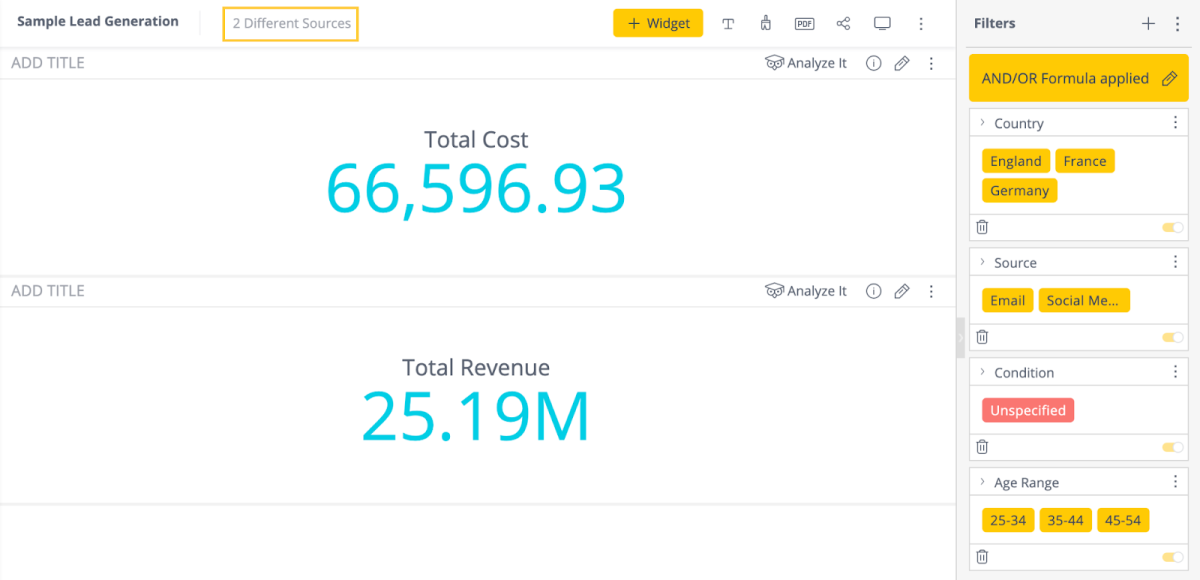
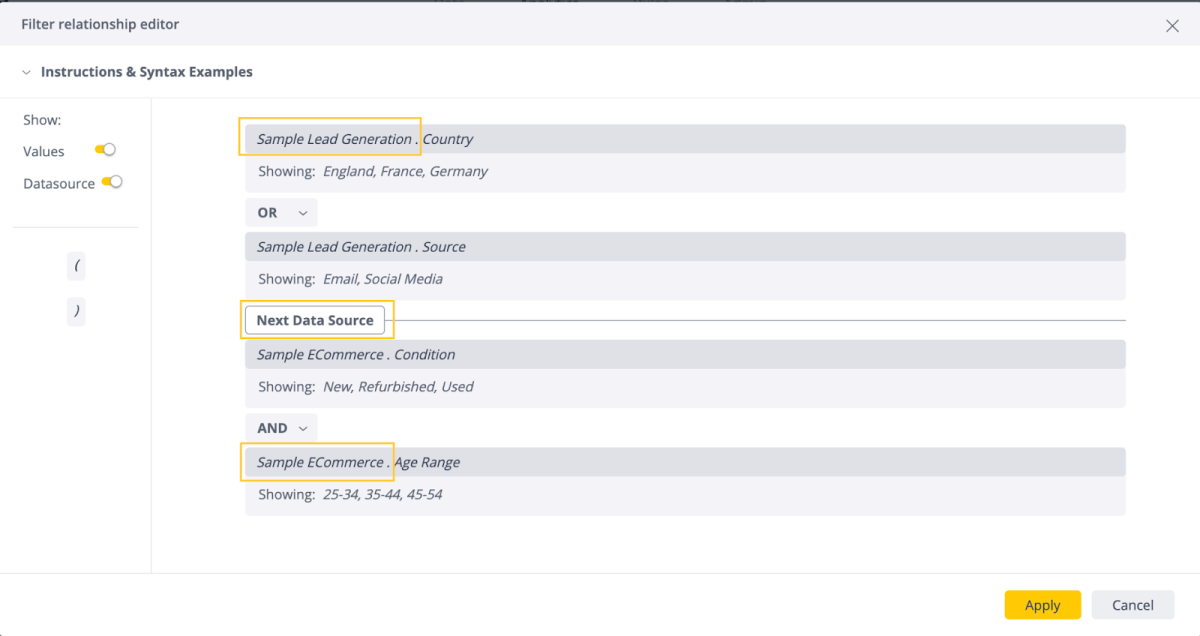
Removing Dashboard Filters Directly from the Filter Relationship Editor
Any dashboard filter removed from the filter panel is also removed from the Filter Relationship Statement, and vice-versa.
Example:
To remove a filter block from inside the filter relationship statement
- Open the filter Relationship Editor.
- Hover over the filter and click
.png) . A confirmation message displays indicating that the
filter will be removed from the statement and from the filter panel.
. A confirmation message displays indicating that the
filter will be removed from the statement and from the filter panel.
.png)
- In the Filter Relationship Editor, click Apply to apply and save the changes.
See Applying Changes.
Viewing Related Errors
View related errors and follow up to mitigate.
Example:
.png)
Disabling Filter Blocks
When you disable a dashboard filter in the filter panel, it is disabled in the filter relationship statement as well, together with its adjacent operator (defined by logical rules). The filter can be reactivated at any time through the filter panel. While disabled, the filter block can be moved around to be relocated in the statement, however it will not affect it. When reactivated, the filter will maintain the statement position set while it was disabled.
Example:
.png)
Viewing the Filter Relationship Statement
You can see the currently applied filter relationship statement inside the dashboard filter panel through the indicator and tooltip.
Example:
- Hover over the AND/OR Formula applied indicator to view the filter statement tooltip.
- Click AND/OR Formula applied to open the Filter Relationship Editor.
.png)
- If you disable the filter, the statement does not appear when you hover over
AND/OR Formula applied, and the filter is disabled in the
Filter Relationship Editor.
.png)
Note:
The filter relationship indicator and the tooltip can be embedded using Sisense.js. Embedding does not apply to the Filter Relationship Editor. See Embedding Dashboards and Widgets.
Setting and Restoring Default Filters
The filter relationship statement you create can be set as your default filter.
Example:
- Create your statement and set it as your default filter.
.png)
- If you make a change to the statement, click Restore my default filters to restore the default filter statement.
See Saving Your Default Filters View for more information.
Viewing Filter Values
View filter values in the Filter Relationship Editor.
Example:
Toggle on Values to see the filter values
.png)
Applying Changes
You can only apply changes when there are no active errors for the statement. The statement is parsed
continuously so if there is an error, a message displays showing what needs fixing.
.png)
Limitations
- The feature is supported only when the Analytical Engine is defined as the main translation strategy and the provider (per dataset) is supported by the New Analytical Engine.
- Select All filters
- Currently filters with a "select all" definition are ignored in the query.
Note:- Given that: Filter 1 is defined as "select all"
- Behavior is: Filter 1 or Filter 2 = Filter 2
- Currently filters with a "select all" definition are ignored in the query.
- Top Ranked filters are not currently supported (error is provided).
- When a widget is set to display filters in Highlight mode, the OR statement is ignored in the highlight results (the values resulting from the OR condition are not highlighted).